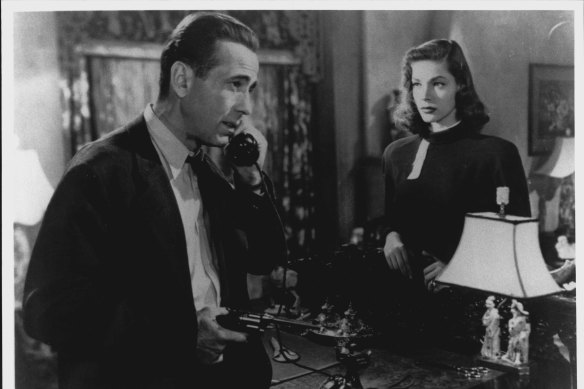
Bogart’s beginnings were in the New York theatre, but the studio’s PR machine didn’t want to know about that. It wouldn’t do for someone whose early career saw him playing tough guy roles to have anything to do with those theatre folks – those “sissies”, as Bogart was required to call them.
But even beyond that kind of PR moulding, Mann contends, the development of Bogie’s screen persona and the cult that grew around him had as much to do with the Warner Bros. style of the time as with any of his specific characteristics.

Humphrey Bogart and Lauren Bacall in a scene from The Big Sleep.
“The stories it told were realistic, gritty, unglamorous, real,” Mann writes. “From his first day at the studio, Bogart absorbed the straightforward unaffected style, carrying it with him throughout his career, using it as the basis of his public image.”
And Mann draws on a killer line in an article penned for The New York Times by Mary Astor, Bogart’s co-star in The Maltese Falcon (1941), to point to the discrepancy between the off-screen Bogart and the on-screen one: “He wasn’t very tall, he had a vocal range from A to B, his eyes were like coal nuggets pressed into his head and his smile was a mistake he tried to keep from happening.”
“The true mother lode”, Mann tells us, is to be found in recently opened personal files – the Bogarts’ and those of their friends (or at least acquaintances), Katharine Hepburn and John Huston – and in the testimony on offer, sometimes anonymously, from those who didn’t want to speak out while Bacall was still alive.
Adding that information to the mix, Mann surveys the couple’s lives apart and together, providing extended overviews of their upbringings, dealing with their careers in detail, and pondering the things that bound them together and pushed them apart, like Bogart’s self-sabotaging alcoholism.
Loading
He traces the obstacle-ridden route Bogart followed to the heights of Hollywood fame. And he examines how Bacall hustled her way up the showbiz ladder, negotiated her way past the antisemitism she encountered, and found herself struggling to adjust to life after Bogart’s death.
He also deals extensively with the couple’s stand against the notorious House Committee on Un-American Activities during the early 1950s. But his primary focus is on the ways in which they were both transformed into players in the Hollywood circus. And how they ended up becoming more of a carefully manufactured brand than a reality, one that required Bogart’s previous marriages to be either pretended away or cast, incorrectly, as miserable precursors to the Real Thing.
Neither Bogie nor Bacall emerges from the book’s 600-plus pages as particularly attractive human beings – Bacall being especially hard to like – although Mann manages to maintain sympathy for both. That they lit sparks when they were together, especially in the early years of their relationship, seems undeniable. But their dismaying failures as parents and their separate pursuits of comfort away from each other also make it clear that their love affair was far from ideal, their domestic harmony an illusion. Still, they were really great together on screen.
The Booklist is a weekly newsletter for book lovers from books editor Jason Steger. Get it delivered every Friday.



























